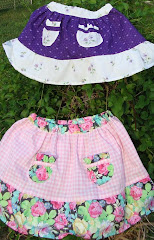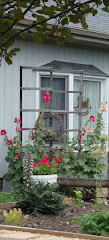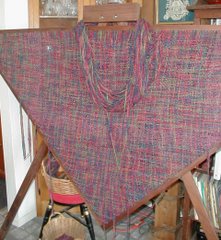Then when I was searching for just the right design for a baby quilt intended as a gift for a friend's adoption, I came across a book at the library, Joan Ford's Scrap Therapy: Cut the scraps and a project she calls "Once Upon a Scrap". As soon as I saw the picture, I knew I wanted to make that quilt and I knew exactly which piece of fabric I wanted to use for the three main sections.
As often happens once I decide on a "dream project" (one that incorporates and builds off favorite fabric, fiber, color, and/or design), the other bits came together without much effort. I used odd bits of cottons I had on hand to cut out almost all of the 180 2-inch squares required for the two patchwork sections. It was a lot of fun searching out blues, greens, reds, yellows in my fabric stash. And I even found a couple of orange prints to use.
Because my mind usually tries to organize things I'm working with into patterns even when I don't want it to, I laid the stacks of colorful squares out on the ironing board and began to play with their layout. I wanted to keep the patchwork section colorful and free without a discernible color placement order. To aid that I purposely cut no more than 10 or 12 squares of any fabric so I wouldn't be able to fall back on a coordinated presentation.
I did end up buying a black, horse shoe-patterned fat quarter that jumped out at me on a trip to the local fabric store where I also found the perfect mottled blue cotton used for one of the borders and the soft flannel print used for the backing. (And what I actually went there to purchase!) Also, I used a wide green double-fold bias tape for the binding because I think it wears better than the straight-cut quilting cotton which the directions called for and while my best wish for this quilt is that it's worn to tatters by the little one it's intended for, I don't want it to be in tatters due to shoddy fabric or workmanship!
The cotton batting recommended quilting or tying at least every 4" or so and since I used flannel for the backing I planned to hand-quilt. (I don't machine-quilt when using flannel for backing as I always have trouble with it "ruffling". YMMV) The simple design encouraged me to just "quilt in the ditch" but the large landscape sections and the long blue border required more coverage.
 DH suggested I do a simple block pattern across those areas but when I attempted that, the white quilting thread didn't look right to me. Usually I love a simple, primitive quilted design like that but it seemed to distract from the colorful quilt. The fabric I couldn't bring myself to cut was instead cut up by little white stitches. Well, not that little -- I average 6-8 stitches to the inch when quilting. My grandmother, who hand-quilted all her work, considered anything less than 10-12 stitches to the inch to be a hazard as, in her words, "you could get your toenail caught in stitches that big!"
DH suggested I do a simple block pattern across those areas but when I attempted that, the white quilting thread didn't look right to me. Usually I love a simple, primitive quilted design like that but it seemed to distract from the colorful quilt. The fabric I couldn't bring myself to cut was instead cut up by little white stitches. Well, not that little -- I average 6-8 stitches to the inch when quilting. My grandmother, who hand-quilted all her work, considered anything less than 10-12 stitches to the inch to be a hazard as, in her words, "you could get your toenail caught in stitches that big!"So this quilt features hand-quilting and tying. I used embroidery floss, blue for the border and green for the design print, to tie the layers together that were deemed not suited to quilting. DH asked me why I didn't consider hand-quilting with colored thread but I couldn't bring myself to use anything except my usual white cotton quilting thread for the hand-quilting. Traditions are hard to break, you know?




























